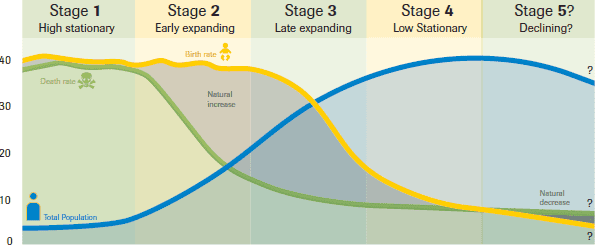This is post 3 of 6 in a series about the Demographic Transition Model – a fundamental concept in population education, which is covered in Social Studies courses, most notably AP Human Geography.

Stage 2 of the Demographic Transition Model (DTM) is characterized by a rapid decrease in a country’s death rate while the birth rate remains high. As such, the total population of a country in Stage 2 will rise because births outnumber deaths, not because the birth rate is rising. The decrease in death rate is commonly attributed to significant improvements in overall health, specifically access to pediatric care, which affects the life expectancy of the most at-risk demographic group — children. But along with basic healthcare, an expanded education system, gender equality, and technological advances in the areas of food production and sanitation also work to decrease the death rate.
The transition to Stage 2 is still a relatively recent phenomenon in human history. Not until the Industrial Revolution did the first countries make the transition from Stage 1 to Stage 2. Since the mid-20th Century most of the world’s countries have not only made it into Stage 2, but have also continued to progress to Stages 3 and 4. Still, there are a number of countries that remain in Stage 2 of the Demographic Transition for a variety of social and economic reasons, including much of Sub-Saharan Africa, Guatemala, Nauru, Palestine, Yemen and Afghanistan.
Demographic Transition Model Stage 2 Case Study: Afghanistan
In 2013, Afghanistan had one of the higher rates of natural increase (birth rate minus death rate; or net increase) in the world at 2.7% – much higher than any other central Asian nation. Data provided from the Population Reference Bureau had the Afghan birth rate at (35/1000) and the death rate at (8/1000). What is most significant here is that the death rate in Afghanistan is low and it continues to decline. Only a decade ago the death rate was over 20/1000, peaking around 2004. This fast reduction in the death rate is interesting to demographers because although life expectancy has risen quickly, one of the primary indicators of a lowered death rate (child mortality) remains high. Afghanistan currently has the highest rate of child mortality in the world, where one in ten children do not live passed the age of 5. Why then the decrease in death rate? Overall public health has greatly improved, and even though the child mortality rate is still high it is an improvement, as is the increased access to food and sanitation that has allowed adults to live longer. Quite remarkable for a country that has experienced so much war during the same time period.
Looking beyond the numbers of birth and death rate brings the discussion back to the Demographic Transition Model’s focus on progress. Like Afghanistan, many countries in Stage 2 are categorized as “developing.” The rates of birth and death are both the cause and effect of social and political factors within a country. Afghanistan has experienced decades of war both internally, and externally, and this has had significant impacts on the overall health and health care system of the country. With continued improvement to both, the expected outcome determined by the DTM is a transition into Stage 3 where total population growth continues, but at a lower rate. The DTM does not provide a time table for transition, but the large gap between the birth and death may signal that the country is nearing the end of Stage 2. For that transition to occur, Afghanistan will need to address outstanding social and economic factors that lead to lower birth rates, most notably in the areas of education and the status of women. Afghanistan has a very high illiteracy rate and limited educational opportunities for women, both indicators towards a high birth rate. Without either of those issues being addressed, the country will remain in Stage 2, with a high rate of population growth. If the current growth rate continues the total population of Afghanistan is expected to double in just 25 years.
Demographic Transition Model blog series: Overview, Stage 1, Stage 2, Stage 3, Stage 4, Stage 5



